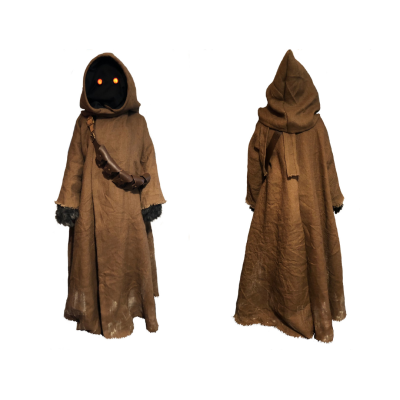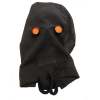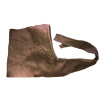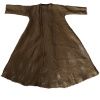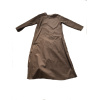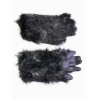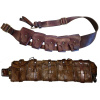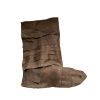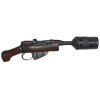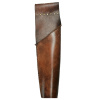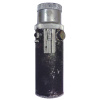Tatooine Jawa - The Mandalorian
Model DZ-3016, Photo by Kelly Wicks Preshaw
Description: Tatooine Jawa
Prefix: DZ
Detachment: Krayt Clan
Context: Star Wars: The Mandalorian
See also: Offworld Jawa
Jawas were passionate scavengers, seeking out technology for sale or trade in the deep deserts in their huge sandcrawler transports. They had a reputation for swindling, as they had a penchant for selling old equipment such as outdated faulty droids to moisture farmers. However, they were extremely passive beings, and hardly put up any resistance to colonists of their planet, unlike the other natives the Sand People, instead seeing foreigners as an excellent business opportunity.
This Visual Guide has been reviewed by the detachment staff and the LMO team and is certified for use as a minimum approval guideline for GMLs. GMLs are free to approve this costume type.
This is a visual guide used for 501st costume approval, not a how-to for construction. Construction details are found at the costume's Detachment website. Measurements provided here are generalized, and not criteria for approval. All 501st costumes are proportionate to the wearer in terms of size, fit, and scale. During evaluation, both text and images (CRL and Reference) must be considered. When in doubt about a feature of a submitted costume, GMLs should post questions in the Legion forum's DL/GML peer review section.
Required Costume Components
The following costume components are present and appear as described below. For 501st membership only the requirements in black need to be met.
Mask
- The mask is face shaped becoming a base upon to mount the two glowing eyes.
- The mask is completely black with a shroud constructed of a black material that hides the entire head and face of the costumer (No parts of the wearer may be visible).
- A black mesh fabric may be used to cover the front of the mask.
- When the mask is worn only the illuminated eyes are visible from inside the hood.
- The eyes are bright orange and approximately ¾ inch (2cm) and do not bulge out.
- Eye-lights are positioned directly below the wearer’s eyes.
Hood
- The hood is a separate piece from the robe and made from the same material.
- A medium Brown color made from (approximately 14oz to 18oz or 390g to 510g) burlap or Hessian.
- Hood is sufficiently large to lap over the robe, hiding the neck opening, draping on the shoulders, with ties tied around the back.
- Hood does not slouch over the mask.
- A wire is sewn into the front rim of the face opening between the black lining and brown fabric, the rim is to be less than ¾ inch (2cm) once sewn, neat with no fraying.
- The hood is hemmed at the bottom; the only seam is up the back.
- The hood extends into ties (no sewn on ties) that overlap at the front and are tied around the back.
- The inside of the hood is lined with solid black fabric.
- The hood must be proportionally sized to the wearer.
Robe
- The robe is made of the same material as the hood.
- A medium Brown colour made from (approximately 14oz to 18oz) burlap or Hessian with sandy weathering.
- The robe opens in the front and overlaps to the right side of the wearer, attached with a hidden clip just under the neck line.
- The sleeves are part of the body of the robe (no shoulder seams), not sewn on separately, and are evenly frayed at the sleeve ends with no more than ¾ inch (2cm) length of fray.
- There is a seam down the back of the robe.
- Sleeves are not to cover the hands; they must end just past the wrist.
- Robe bottom frayed ¾ inch (2cm) length of fray.
- None of the fray is long strings all even.
- Robe to have sandy coloured weathering.
Under Tunic
- Tunic is Brown.
- Tunic is a full length robe with long sleeves.
- Tunic may be as long as the main robe.
- Tunic sleeve cuffs are sewn.
- The tunic’s bottom hem and sleeves may be visible from under the robe.
Hands/Gloves
- The hands have a PVC palm with black rubber tips.
- The Hands have a black med length fur covering all top of the hand up to the wrist.
Bandoliers
- At least one (1) bandolier is worn across the chest.
- Bandoliers are of British 1903 pattern, Martini Henry, Turkish Ottoman, Swedish, British, NZ, Australian, Canadian, German or similar recreations.
- Bandoliers are of brown/Tan leather or similar looking material and visual weight.
- The bandolier(s) are aged and weathered. All metal pieces are dull, worn and scuffed with little shine to them.
- Chest bandoliers are not worn tight up under the armpit area; they reach at least to the waist.
- Extension straps may be added for the bandoliers in order for them to hang low enough.
- Up to two (2) bandoliers may be worn at the same time.
- One bandolier across the shoulder to the waist.
- If two bandoliers are worn, they are crossed over the chest in an “X” formation to the waist.
- Jawas do not wear bandoliers around the waist.
Boots
- The boots are wrapped in the same brown textured fabric as the tunic.
- The boots are tall enough to cover the mid-shin or higher.
- The boots can be slightly weathered.
Optional Accessories
Items below are optional costume accessories. These items are not required for approval, but if present appear as described below. If adding in an accessory after initial approval, the item still needs to be submitted to local GML for approval before use.
Ion Blaster, ANH
- This is one acceptable version of ion blaster.
Ion Blaster, RotJ
- This is another acceptable version of ion blaster.
Holster
- The holster in which to carry the Ion Blaster.
Torch welder
- Microflame gas brazing torch or similar.
- Box frame with two (2) control knobs on top, extended torch arm, and cylinders in center.
Droid caller
- Made from a vintage Kobold camera flash, or replica.
- Cylindrical tube with a silver upper section and a black textured lower section, silver rectangle detail piece is attached to center, with several small knobs on side.
